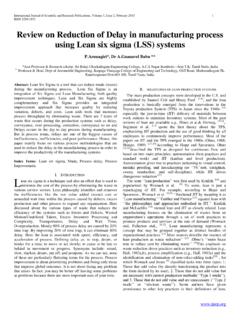Transcription of Lean Six Sigma – Change Management
1 lean Six Sigma Change Management The Green Belt programme introduces the principles and basic tools of Change Management because lean Six Sigma projects are Change projects they Change the way the process is currently performed and therefore Change what the people working in and supporting the process do. The power of the DMAIC approach will overcome even problems which were previously thought to be beyond resolution but in many environments getting people to buy-in to the new way can be a considerable challenge. That slows down the delivery of the improvement and results in it not achieving its maximum potential. Sometimes it even fails.
2 The course will help enable you to be an effective manager of Change and achieve the full potential of your project. When Change Management is done well, people feel engaged in the Change process and work collectively towards a common objective, realising benefits and delivering results. Who is the course for? You are a lean Six Sigma Project Champion, Black Belt, Green Belt, Project Team Member, lean Practitioner, Continuous Improvement Practitioner, Project Manager, Deployment Leader or Change Agent and you want to develop your knowledge and core skills to be an effective manager of Change in your organisation You would like a refresher as well as to learn additional tools on how to effectively win commitment to your project in a format that seamlessly integrates with the lean Six Sigma DMAIC process You would like to practice how to overcome resistance to Change from others to implement your lean .
3 lean Six Sigma or Continuous Improvement project in a safe environment You would like learn how to apply in your workplace the key techniques of enhancing your communication with your project Stakeholders as well as to experiment with other approaches You are from a service or manufacturing organisation. You are seeking a highly participative programme that will provide you with a breakthrough approach to managing Change to support the implementation of a lean Six Sigma project. You have begun your journey towards becoming a Black Belt or Green Belt and want to complement the application of the harder skills of lean Six Sigma with the soft, people side of the toolkit in order to smooth the way to a successful completion of your improvement project Learning Outcomes This course provides you with a unique combination of Change tools and skills targeted at lean Six Sigma practitioners.
4 The course teaches you to: Understand how Change happens in organisations Understand the culture of your organisation and how you need to manage Change within this context Understand your role as a Change agent Understand your preferred styles and be able to use appropriate interpersonal skills to engage with, influence and help others to accept Change Outcomes for Your Business Delegates are equipped with the knowledge and fundamental skills to be an effective manager of Change in their organisation and thereby maximise the effectiveness and financial returns of improvement projects. Outcomes for Your Personal Development Following successful completion of this course, you will possess a comprehensive set of Change Management tools to enable you to effectively manage a lean Six Sigma or Change Project and so contribute to career advancement opportunities.
5 How can I take this course? This programme is delivered typically over 3 days. We deliver it in-house and frequently at our open training venues (London, Birmingham) Support Pack All classroom delegates receive: 12 months access to Catalyst s online Business Improvement Zone over 60 short videos recorded live in the classroom covering the entire Managing Change course content Printed and pdf copies of the course slides The book Persuasion - the art of influencing people by James Borg The Managing Change Pocket Guide Downloadable Change Management Tools and Templates Follow-on Options British Quality Foundation Green/Black Belt Certification Project Coaching Support Service Courses which follow on directly include.
6 lean Six Sigma for Innovation and Design (Design for Six Sigma ) Advanced Green Belt Black Belt Managing Change Course Contents Introduction & Goals of the module The case for Managing Change Change process Overview J Kotter 8 steps in Managing Change The Elements of Change How it fits with DMAIC Basic Skills for leading Change Profile of a Facilitative leader Effective meetings Team Roles Role contracting Team stages/GRIP Step 1 Establish the Need The Culture Web and States of Change Creating a sense of urgency Threats and opportunities matrix 3Ds Step 2 Build Stakeholder Engagement Stakeholder Analysis Resistance TPC Force field
7 Understanding the Change environment Schein & Lewin s States of Change Kubler-Ross Cycle Step 3 - Develop the Vision and Plan Visioning Backward Visioning More of/Less of Step 4 - Communicate, Communicate, Communicate Communications Plan Elevator Speech Rapport/Body Language Active Listening Questioning Step 5 Make Change Happen Self-awareness Emotional Intelligence Preferred leadership styles Managing conflict Step 6 Embed the Change Systems and Structures/Culture Web Training & Development Planning Coaching using the GROW model Reward & Recognition Planning Step 7 Monitor and refresh Monitoring/ Culture Audit Change Skills self-assessment What next?
8 Preparing for re-entry action planning





